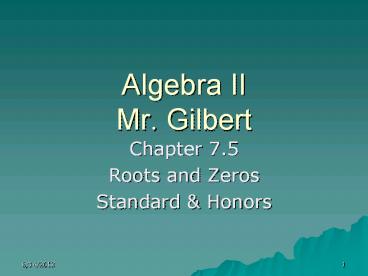Algebra II Mr' Gilbert PowerPoint PPT Presentation
Title: Algebra II Mr' Gilbert
1
Algebra IIMr. Gilbert
- Chapter 7.5
- Roots and Zeros
- Standard Honors
2
Students shall be able to
- Determine and find the number and type of roots
for a polynomial
- Find the zeros of a polynomial equation.
3
Agenda
- Warm up
- Home Work
- Lesson
- Practice
- Homework
4
Homework Review
5
Communicate Effectively
- Theorem
- A proposition that has been or is to be proved
on the basis of explicit assumptions. - The Fundamental Theorem of Algebra
- Every polynomial equation with a degree greater
than 0 has at least one root in the set of
complex numbers. - Complex Conjugates Theorem
- For every polynomial, if there exists a complex
root abi then a-bi also exists.
6
Lesson 5 Contents
Example 1 Determine Number and Type of
Roots Example 2 Find Numbers of Positive and
Negative Zeros Example 3 Use Synthetic
Substitution to Find Zeros Example 4 Use Zeros to
Write a Polynomial Function
7
Example 5-1a
Answer This equation has exactly one real root,
10.
8
Example 5-1b
Answer This equation has two real roots, 8 and
6.
9
Example 5-1c
Use the Zero Product Property.
10
Example 5-1d
11
Example 5-1e
12
Example 5-1f
Answer This equation has two real roots, 2 and
2, and two imaginary roots, 2i and 2i.
13
Example 5-1g
Answer This equation has exactly one root at 3.
Answer This equation has exactly two roots, 3
and 4.
14
Example 5-1h
Answer This equation has two real roots, 3 and
3, and two imaginary roots, 3i and 3i.
15
Example 5-2a
Since p(x) has degree 6, it has 6 zeros. However,
some of them may be imaginary. Use Descartes Rule
of Signs to determine the number and type of real
zeros. Count the number of changes in sign for
the coefficients of p(x).
yes to
yes to
no to
no to
16
Example 5-2b
Since there are two sign changes, there are 2 or
0 positive real zeros. Find p(x) and count the
number of sign changes for its coefficients.
no to
no to
yes to
yes to
Since there are two sign changes, there are 2 or
0 negative real zeros. Make a chart of possible
combinations.
17
Example 5-2c
Answer
18
Example 5-2d
Answer The function has either 2 or 0 positive
real zeros, 2 or 0 negative real zeros, and 4, 2,
or 0 imaginary zeros.
19
Example 5-3a
Since f (x) has degree of 3, the function has
three zeros. To determine the possible number
and type of real zeros, examine the number of
sign changes in f (x) and f (x).
yes
yes
no
no
no
yes
20
Example 5-3b
The function has 2 or 0 positive real zeros and
exactly 1 negative real zero. Thus, this function
has either 2 positive real zeros and 1 negative
real zero or 2 imaginary zeros and 1 negative
real zero.
To find the zeros, list some possibilities and
eliminate those that are not zeros. Use a
shortened form of synthetic substitution to find
f (a) for several values of a.
Each row in the table shows the coefficients of
the depressed polynomial and the remainder.
21
Example 5-3c
22
Example 5-3d
23
Example 5-3e
24
Example 5-3f
25
Example 5-4a
Short-Response Test Item Write a polynomial
function of least degree with integer
coefficients whose zeros include 4 and 4 i.
Read the Test Item If 4 i is a zero, then 4
i is also a zero, according to the Complex
Conjugate Theorem. So, x 4, x (4 i), and
x (4 i) are factors of the polynomial
function.
26
Example 5-4b
Solve the Test Item Write the polynomial
function as a product of its factors.
Multiply the factors to find the polynomial
function.
27
Example 5-4c
28
Example 5-4d
29
Example 5-4e
Short-Response Test Item Write a polynomial
function of least degree with integer
coefficients whose zeros include 2 and 1 i.
30
Homework
See Syllabus 7.5

